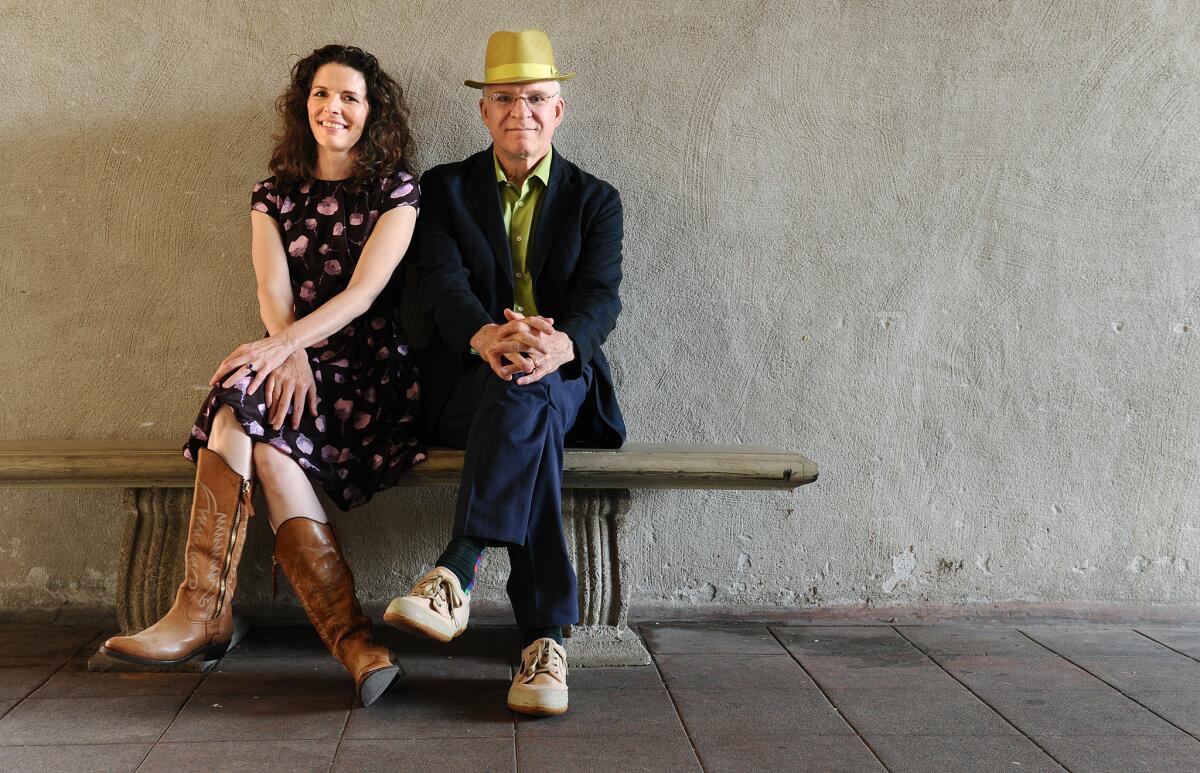Steve Martin, Edie Brickell take musical detour with ‘Bright Star’

Reporting from San Diego — In the basement of the House of Charm, watching a group of people sing and dance, Steve Martin consults his iPad and prepares, once again, to transform.
Above him, Balboa Park goes about its business. Tourists arrive by red trolley, brides pose amid the greenery, families take advantage of the pre-Labor Day lull and head to the zoo; the park’s many museums are not yet open, so the buildings serve mostly as Mission Revival backdrop.
The House of Charm is a multipurpose building housing the San Diego Art Institute’s Museum of the Living Artist, the Mingei International Museum and, in the basement, rehearsal space for its across-the-way neighbor, the Old Globe Theatre.
Fall arts preview 2014: The season in music, theater and more
It’s a fitting work environment for Martin, who is himself multipurpose: comedian, actor, art collector, musician, writer, Oscar host and, before all that, magician. Every three or four years, it seems, he makes a foray into another medium, another genre, inevitably accompanied by media fanfare. In part because “Steve Martin” remains one of entertainment’s more famous names but mostly because such elasticity is rare, Martin’s closest cousin in artistic diversity may be Stephen Fry.
To Martin, about to add “musical theater” to his already varied writing credits, it’s more like a game of conditional-logic hopscotch.
“My whole career has been, ‘If I can do this, then I might be able to do that,’” Martin says. “If I can write comedy, maybe I can do stand-up. If I can do stand-up, maybe I can act in a movie. If I can act in a movie, maybe I can write a screenplay. If I can write a screenplay, maybe I can write a play. If I wrote a play, and music, then maybe I could write a musical.”
This, then, is an early rehearsal for that musical, “Bright Star,” which he has written with fellow Grammy winner and recent touring partner Edie Brickell; it will open at the Old Globe Sept. 28, but previews began Saturday.
Seated next to him, Brickell, who is tall, slender and loose-limbed, rummages through her large brown purse. The iPad is on a table in front of them, balanced upright on its keyboard, and occasionally, she leans her head toward Martin’s as they consult the script on its screen and each other. She is wearing jeans and Nikes with neon-green soles. Though he is more formally attired in blue blazer and slacks, green-striped socks peek out from below the cuffs.
The greens do not match but are each an interesting choice.
As is “Bright Star.” Set in North Carolina’s Blue Ridge mountains during the 1920s and ‘40s, it tells the story of a young veteran (A.J. Shively) who, upon returning home, meets a literary editor (played by Carmen Cusak) who helps him address his future while coming to terms with his past.
These days, original musicals of any type, never mind one billed as “Americana with a touch of rock,” are rare, and for good reason. It’s tough to compete with “Mary Poppins” or “Matilda,” adaptations with built-in fan appeal. For Brickell, previously known as a singer-songwriter of varying types of music, it’s a huge leap. Even for Martin, “Cheaper by the Dozen: The Musical” would have been a safer bet.
Especially since, just so you can’t say no one told you, neither Martin nor Brickell will appear in “Bright Star.” Martin wrote the book, Brickell the lyrics and they collaborated on the music, but those attending “Bright Star” in anticipation of, say, a character known only as the White-haired Banjo Player will wait in vain.
“They are not in the show any more than Edward Albee was in his plays,” says director Walter Bobbie, with a rueful laugh that anticipates some, if not many, ticket holders who expect an appearance by Martin all the same.
The expectation is understandable. It’s hard to imagine a first musical being directed by Bobbie at the Old Globe without someone famous being attached, and famous someones are almost always on stage. Especially when they are as good and versatile as Steve Martin. While Martin hasn’t given up acting — he voices one of the characters in the upcoming DreamWorks film “Home” and recently agreed to star in the Disney film “Magic Camp” — he wasn’t even tempted to appear in “Bright Star.”
“I just don’t have the stamina,” Martin says of the eight performances a week theater requires. There is no joke on the downbeat because Martin is not a compulsive performer. He listens carefuly to questions and answers them; he does not speak in one-liners or riffs.
“Bright Star” was, originally, based on the songs Martin and Brickell wrote for “Love Has Come for You,” their 2013 album, whose title song won a Grammy for American roots song earlier this year.
The two met at a dinner 20 years ago, just after Brickell had married Paul Simon, a longtime friend of Martin’s. “He was really nice to me,” says Brickell. “Everyone else was looking at me like, ‘Who’s the new kid?’ And he actually talked to me.”
But it wasn’t until three years ago, after Martin had been performing off and on with the Steep Canyon Rangers, that Brickell asked if he wanted to write a song together.
Martin obliged. On vacation, he began sending her banjo tracks. “I figured, ‘Oh, I should send her a fast one now, or a slow one.’ I figured one song. I didn’t think it would be 13. Or 50.”
On her end, Brickell viewed every email like a Christmas present. Soon they had an album, and then, of course, came the tour. “I had already learned that if you have an album, you have to have the tour,” Martin says. “Or so my agent tells me.”
Martin being who he is, that tour quickly became a hybrid of music and comedy. Along the way, the two shared their love of old movies and musical theater. They talked about writing a musical, and when Edie suggested they look at the songs they had already written, Martin thought that might work.
“Might” being the operative word.
“We didn’t really have a story,” Martin says, “which made it difficult. I would never attempt this again,” he adds, his voice rising to its more familiar round tones and higher volume, as if he were speaking to the kids at home, “without a clear story in mind first.”
They did have, according to Brickell, Martin’s vivid and very human imagination. “Steve creates these beautiful characters, this wonderful story,” she says, “and it’s like a spider web that you can hang music on.”
The two also shared an understanding of how the creative process works and a willingness to, as the quote goes, murder their darlings. Which they did, quite ruthlessly; what began as a musical based on the 13 songs from “Love Has Come for You,” now has 25 songs, only two of which are from the album.
“Writing novels has made me used to juggling characters,” Martin says. “Someone enters on page 36 and will be back on page 112. A musical is different, though. We got to one scene with three characters interacting, and now it’s time for a song. And Edie just picked up the scene, did this song with three voices that just staggered me, and suddenly I didn’t need half of what I’d written in the scene. So we cut it.”
He was happy to learn that his partner not only worked fast, but she also understood that you can’t move forward without letting go.
“In comedy, you literally cannot hang on to anything if it isn’t working, or if it’s only halfway working,” Martin says. “Working with Carl Reiner, I learned that when something is your favorite, your favorite scene or your favorite line, and the thing works faster without it, your favorite has got to go. The song on which this entire show is based,” Martin says, with a glimpse of that famous double-jointed smile, “we cut that. We didn’t need it anymore.”
Still, he adds, “If they told you ahead of time how hard it would be, you’d never do it. So,” he adds, offering another smile. “it’s good when they don’t.”
Bobbie, on the other hand, knew exactly how hard it would be. The Tony Award-winning director of “Chicago,” who came on board at the behest of Old Globe Artistic Director Barry Edelstein, found the original script for “Bright Star” eccentric, soulful and touching, he says, but “it needed work.”
He had known Martin for many years and wanted to be very clear very quickly about that. “Steve can call any director he wanted, he could call Mike Nichols,” Bobbie says. “I didn’t want anyone second-guessing me midway through. So I needed everyone to understand what I thought needed to happen.”
Martin and Brickell, he says, responded “like kids in a playground. They know how to respond to information and not lose that wonderful original voice.” Though there’s plenty of humor, along with the music, Bobbie says, “Bright Star” is romantic in the largest sense of the word, which is to say sincere and hopeful. “It’s so rare, these days,” he says. “I’m so tired of going to the theater and seeing people who are ‘over it.’”
So here they are, watching one of the songs that did not get cut be choreographed in the basement of the Charm building. Half of the room is used as a stage — there is a raised platform and a makeshift bar marked “Bar.” The other half is full of long tables littered with the detritus of life in the theater: water bottles and bags of snacks, cups holding various caffeinated beverages, binders and pens, staple guns and iPhones, a rainbow mountain of the thin colored tape used for blocking.
Under the businesslike glare of overhead lighting, a group of actors runs through another piece of choreography for the bouncing kick-dancer of the song with a “Pour me another round” chorus.
“Ten minutes,’ the stage manager says, mistakenly announcing a break..
“No, wait,” the choreographer says, “we’re running it again.”
“We’re running it again,” says Martin in a deadpan tone, “and it’s your break.”
It’s the only thing he says to the group during the rehearsal, but it gets a big laugh. The man behind the iPad is Steve Martin after all.
More to Read
The biggest entertainment stories
Get our big stories about Hollywood, film, television, music, arts, culture and more right in your inbox as soon as they publish.
You may occasionally receive promotional content from the Los Angeles Times.











